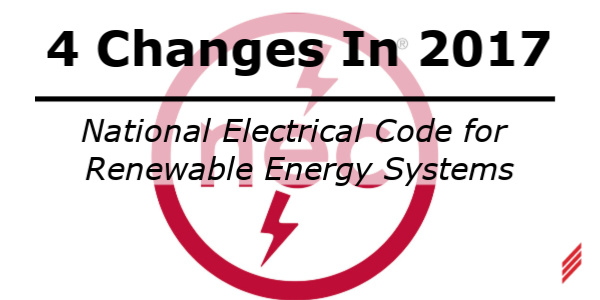4 Changes to 2017 National Electrical Code for Renewable Energy Systems
by John Butterfield on Jun 2, 2016 4:05:44 PM

One cannot help but notice the increase in solar and wind powered electrical generating sites that seem to be appearing everywhere. Authorities, investors, designers, installers, owners, and the general public are being challenged to address the environmental, operation and safety impacts of these systems.
New articles related to the generation, distribution, and utilization of electrical energy have been included for the 2017 National Electrical Code® (NEC®). Here is an overview of the NEC Articles related to changes in the power production market.
Article 691 – Large-Scale Photovoltaic (PV) Electric Supply Stations
The Scope of this proposed Article states: “Electric supply stations are locations containing the generating stations and substations, including their associated generator, storage battery, transformer, and switchgear areas.” These systems are “operated for the sole purpose of providing electric supply to the utility transmission or distribution system with a generating capacity of no less than 5,000KW.”
Large-scale photovoltaic (PV) stations are designed for the supply of merchant power into the electrical grid. These stations are differentiated from most building-mounted and other decentralized solar power applications in that they supply power at the utility level, rather than to local users. These facilities are sometimes referred to as solar farms, especially when located in agricultural areas. A utility-scale solar system is sometimes used to describe this type of large-scale project. The rapid increase in the number of large-scale PV electric supply stations presents new challenges to Authorities Having Jurisdiction (AHJs). Due to the complexity of these systems, it is unlikely that the AHJ will have expertise in the design and construction of multi-megawatt PV power plants. Many of the components of a large-scale PV electric supply station do not and cannot comply with the current requirements of Article 690 (Solar Photovoltaic Systems) in the 2014 NEC. The two main drivers for Article 691 are: 1) elimination of AHJ professional risk when assessing compliance of large-scale PV electric supply stations, and 2) enabling system engineers to use engineering best practices in the design of large-scale PV electric supply stations.
Article 706 – Energy Storage Systems
This article applies to all permanently installed Energy Storage Systems (ESS) that may be stand-alone or interactive with other electric power production sources. An Energy Storage System is one or more devices, assembled together, capable of storing energy for use at a future time. ESS’s include, but are not limited to, electrochemical storage devices (e.g., batteries), flow batteries, capacitors, and kinetic energy devices (e.g., flywheels and compressed air). These systems can have AC or DC output for utilization and can include inverters and converters to change stored energy into electrical energy. Currently, batteries are addressed in numerous places in the current NEC; Article 480 (Storage Batteries, historically, lead-Acid batteries) and Article 690 (Photovoltaic Systems). The current state of energy storage technology, which includes batteries, and the anticipated evolution of energy storage support the need for a singular set of requirements in the NEC covering such systems.
Article 710 – Stand-Alone Systems
Comments received on covering stand-alone electric systems resulted in the acceptance of a new article, Article 710. This Article addresses electric power production sources operating in stand-alone mode.
Article 712 – Direct-Current Microgrids
As stated in Section 712.2: “A Direct Current Microgrid is a power distribution system consisting of one or more interconnected DC power sources, DC-DC converters, DC loads, and AC loads powered by DC-AC inverters. A DC Microgrid is typically not directly connected to an AC primary source of electricity. However some DC Microgrids interconnect via one or more DC-AC bidirectional converters or DC-AC inverters.”
DC Microgrids are related to the direct utilization of power from DC sources to direct-current loads—such as LED lighting, communications equipment, computers and servers, variable-speed motor drives, HVAC equipment, etc. Direct utilization of DC—whether generated by PV systems, fuel cells or other means, without intervening DC–AC and AC–DC conversion steps—leads to higher efficiencies and potentially smaller and lower-cost equipment than AC–coupled methods. The need for higher efficiency in telecom and data centers has driven these industries to implement DC Microgrids in hundreds of data centers around the world. It is a trend that will likely continue. Data centers currently use about 30 gigawatts of electrical power while about 30% of the worldwide data center load is in the USA.
These are new areas in the 2017 National Electric Code that the MEP Engineering community should be aware of.
About the author
John has retired from Hallam-ICS, but his contributions to the company continue to be valued.
Read My Hallam Story
About Hallam-ICS
Hallam-ICS is an engineering and automation company that designs MEP systems for facilities and plants, engineers control and automation solutions, and ensures safety and regulatory compliance through arc flash studies, commissioning, and validation. Our offices are located in Massachusetts, Connecticut, New York, Vermont and North Carolina and our projects take us world-wide.
You May Also Like
These Related Stories

Reducing Carbon Emissions by Electrification

How EPlan Improves Control Panel Design Efficiency




Comments (1)